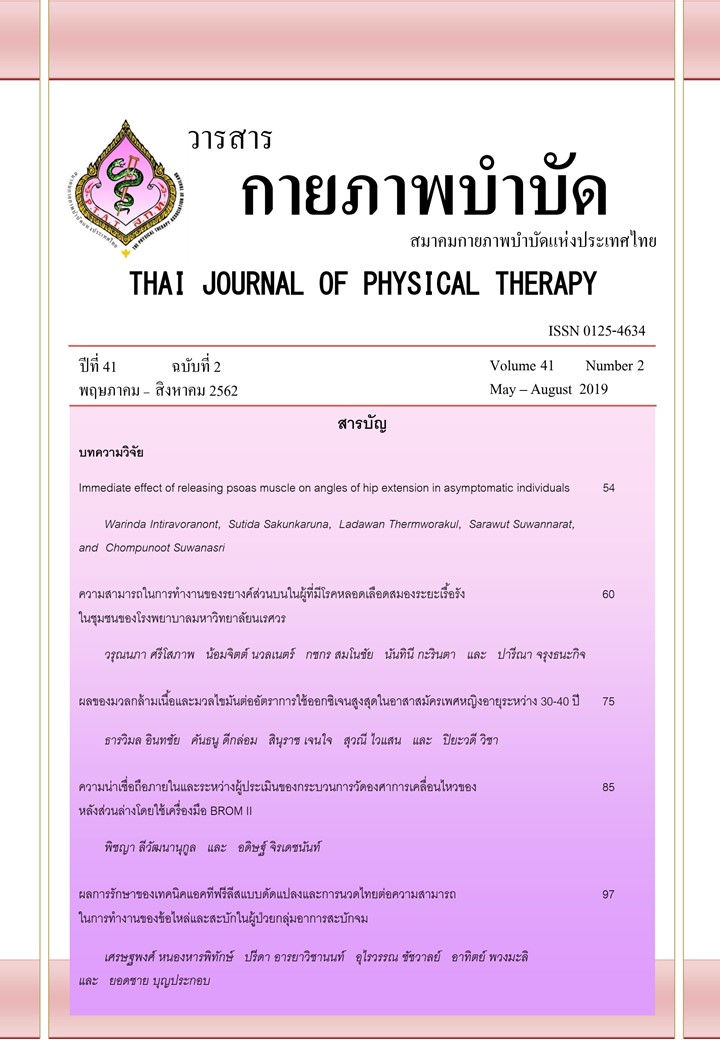ผลการรักษาของเทคนิคแอคทีฟรีลีสแบบดัดแปลงและการนวดไทยต่อความสามารถในการทำงานของข้อไหล่และสะบักในผู้ป่วยกลุ่มอาการสะบักจม
Main Article Content
บทคัดย่อ
ที่มาและความสำคัญ: ปัจจุบันมีการศึกษาเปรียบเทียบหัตถบำบัดที่ใช้ในการรักษาผู้ป่วยกลุ่มอาการสะบักจม ได้แก่ เทคนิคแอคทีฟรีลีสแบบดัดแปลงและการนวดไทย อย่างไรก็ตาม ยังไม่มีการศึกษาเปรียบเทียบความแตกต่างของผลการรักษาทั้งสองวิธีต่อความสามารถในการทำงานของข้อไหล่และสะบักในผู้ป่วยกลุ่มอาการสะบักจม
วัตถุประสงค์: เพื่อเปรียบเทียบผลการรักษาระหว่างเทคนิคแอคทีฟรีลีสแบบดัดแปลง และการนวดไทยต่อความสามารถในการทำงานของข้อไหล่และสะบักในผู้ป่วยกลุ่มอาการสะบักจม
วิธีการวิจัย: ผู้ป่วยกลุ่มอาการสะบักจม สุ่มตัวอย่างเป็น 2 กลุ่ม ได้แก่ กลุ่มที่ได้รับการรักษาด้วยเทคนิคแอคทีฟรีลีสแบบดัดแปลง (จำนวน 35 คน) และกลุ่มที่ได้รับการรักษาด้วยการนวดไทย (จำนวน 35 คน) เวลาและความถี่ของการใช้วิธีการรักษาทั้งสองชนิดในการศึกษาครั้งนี้คือ หนึ่งครั้ง 30 นาที และ 3 ครั้งต่อสัปดาห์ ในระยะเวลา 3 สัปดาห์ ตัวแปรที่ใช้ในการศึกษาครั้งนี้ได้แก่ ความสามารถในการทำงานของข้อไหล่และสะบักโดยใช้แบบสอบถามความสามารถของการใช้แขน ไหล่ และมือในการทำกิจกรรมฉบับย่อ (quick disabilities of the arm, shoulder and hand questionaire) และองศาการเคลื่อนไหวของคอและข้อไหล่โดย cervical range of motion goniometer (CROM goniometer) และเครื่องมือโกนิโอมิเตอร์แบบมาตรฐาน ตามลำดับ โดยประเมินผลก่อนการรักษา สัปดาห์ที่สามและสัปดาห์ที่แปดหลังการรักษาครั้งแรก การวิเคราะห์ผลก่อนและหลังการรักษาภายในกลุ่มใช้สถิติ repeated measure ANOVA และการวิเคราะห์ผลความแตกต่างระหว่างกลุ่มใช้สถิติ ANCOVA โดยใช้ค่า pre-test เป็นตัวแปรร่วมในการศึกษา
ผลการวิจัย: เมื่อเปรียบเทียบภายในกลุ่มพบว่า ตัวแปรทุกค่าของทั้งสองกลุ่มเพิ่มขึ้นอย่างมีนัยสำคัญทางสถิติ (p<0.05) ที่สัปดาห์ที่สามและสัปดาห์ที่แปดเมื่อเปรียบเทียบกับก่อนการรักษา แต่ผลของตัวแปรทั้งสองเมื่อเปรียบเทียบระหว่างสัปดาห์ที่สามและสัปดาห์ที่แปดไม่มีความแตกต่างอย่างมีนัยสำคัญทางสถิติ (p>0.05) ยิ่งไปกว่านั้น เมื่อเปรียบเทียบระหว่างกลุ่มพบว่า ค่าตัวแปรทุกค่าไม่มีความแตกต่างอย่างมีนัยสำคัญทางสถิติ (p>0.05)
สรุปผล: เทคนิคแอคทีฟรีลีสแบบดัดแปลงและการนวดไทยมีผลระยะสั้นและระยะยาวในการเพิ่มความสามารถในการทำงานของข้อไหล่และสะบัก และองศาการเคลื่อนไหวของคอและข้อไหล่ในผู้ป่วยกลุ่มอาการสะบักจมไม่แตกต่างกัน
Article Details
เอกสารอ้างอิง
2. Eungpinichpong W. Therapeutic Thai massage. Bangkok: Chomromdek Publishing House; 2008.
3. Abrams B. Scapulocostal syndrome. In: Waldman SD, editor. Pain management, vol. 2. Philadelphia: Saunders; 2011: 588-92.
4. Fourie LJ. The scapulocostal syndrome. S Afr Med J 1991; 79: 721-4.
5. Schmerl M. Clinical update: Scapulo-costal syndrome. Australasian Chiropractic Osteopathy 2002; 10(2): 85-86.
6. Hidalgo-Lozano A, Fernández-de-las-Peñas C, Calderón-Soto C, Domingo-Camara A, Madeleine P, Arroyo-Morales M. Elite swimmers with and without unilateral shoulder pain: mechanical hyperalgesia and active/latent muscle trigger points in neck-shoulder muscles. Scand J Med Sci Sports 2013; 23(1):66–73.
7. Jaeger B. Myofascial trigger point pain. Alpha Omegan 2013; 106(1–2):14–22.
8. McNulty WH, Gevirtz RN, Hubbard DR, Berkoff GM. Needle electromyographic evaluation of trigger point response to a psychological stressor. Psychophysiology 1994; 31(3):313-16.
9. Simons DG, Travell JG, Simons LS. Myofascial pain and dysfunction: The trigger point manual. Volume 1, 2nd ed. Baltimore: Williams & Wilkins; 1999.
10. Grant KE, Riggs A. Myofascial Release In: Stillerman E, editor. Modalities for massage and bodywork, vol. 2. Philadelphia: Saunders; 2015: 149-66.
11. Wannapong N, Boonprakob Y, Chatchawan U, Wanpen S, Phadungkit S. Immediate and short term effect of modified active release technique (mART) in patients with scapulocostal syndrome. Bull Chiang Mai Assoc Med Sci 2016; 49(1): 134-45.
12. Nongharnpitak S, Arayawichanon P, Chatchawan U, Mato L, Puangmali A, Boonprakob Y. Comparative study of the immediate therapeutic effects between modified active release technique and traditional Thai massage on pain alteration in patient with scapulocostal syndrome. Journal of Associated Medical Sciences 2017; 50(3): 391-403.
13. Buttagat V, Eungpinichpong W, Chatchawan U, Arayawichanon P. Therapeutic effects of traditional Thai massage on pain, muscle tension and anxiety in patients with scapulocostal syndrome: a randomized single-blinded pilot study. J Bodyw Mov Ther 2012; 16: 57-63.
14. Viriyatharakij N, Wangyapongsataporn K. Charoensuksiri S, Wuttimetha S. Ability of arm in condition of pain and non-scapular muscle pain. Thai J Phys Ther 2013; 35: 148-56.
15. Borm GF, Fransen J, Lemmens WA. A simple sample size formula for analysis of covariance in randomized clinical trials. J Clin Epidemiol. 2007; 60(12): 1234-8.
16. Angst F, Schwyzer HK, Aeschlimann A, Simmen BR, Goldhahn J. Measures of Adult Shoulder Function. Arthritis Care Res 2011; 63(11): 174-88.
17. Tongprasert S, Rapipong J, Buntragulpoontawee M. The cross-cultural adaptation of the DASH questionnaire in Thai (DASH-TH). J Hand Ther. 2014; 27(1): 49-54. doi: 10.1016/j.jht.2013.08.020.
18. Audette I, Dumas JP, Cote JN, De Serres SJ. Validity and between-day reliability of the cervical range of motion (CROM) device. J Orthop Sports Phys Ther. 2010; 40: 318–23.
19. Abbott JH. Mobilization with movement applied to the elbow affects shoulder range of motion is subject with lateral epicondylagia. Man Ther 2001; 6(3): 170-7.
20. Mutlu E, Birinci T, Dizdar G, Ozdincler AR. Latent Trigger Points: What Are the Underlying Predictors?. Arch Phys Med Rehabil 2016; 97(9): 1533-41.
21. Chatchawan U, Thinkhamrop B, Kharmwan S, Knowles J, Eungpinichpong W. Effectiveness of traditional Thai massage versus Swedish massage among patients with back pain associated with myofascial trigger points. J Bodyw Mov Ther 2005; 9: 298-309.
22. Ibarra JM, Ge HY, Wang C, Martínez Vizcaíno V, Graven-Nielsen T, Arendt-Nielsen L. Latent myofascial trigger points are associated with an increased antagonistic muscle activity during agonist muscle contraction. J Pain 2011; 12(12): 1282-8. doi: 10.1016/ j.jpain.2011.09.005.


